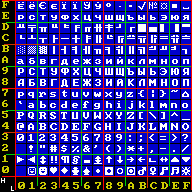Related Research Articles

Code page 866 is a code page used under DOS and OS/2 in Russia to write Cyrillic script. It is based on the "alternative code page" developed in 1984 in IHNA AS USSR and published in 1986 by a research group at the Academy of Science of the USSR. The code page was widely used during the DOS era because it preserves all of the pseudographic symbols of code page 437 and maintains alphabetic order of Cyrillic letters. Initially this encoding was only available in the Russian version of MS-DOS 4.01 (1990), but with MS-DOS 6.22 it became available in any language version.
Windows-1257 is an 8-bit, single-byte extended ASCII code page used to support the Estonian, Latvian and Lithuanian languages under Microsoft Windows. In Lithuania, it is standardised as LST 1590-3, alongside a modified variant named LST 1590-4.
MIK (МИК) is an 8-bit Cyrillic code page used with DOS. It is based on the character set used in the Bulgarian Pravetz 16 IBM PC compatible system. Kermit calls this character set "BULGARIA-PC" / "bulgaria-pc". In Bulgaria, it was sometimes incorrectly referred to as code page 856. This code page is known by FreeDOS as Code page 3021.
Code page 775 is a code page used under DOS to write the Estonian, Lithuanian and Latvian languages. In Lithuania, this code page is standardised as LST 1590-1, alongside the related Code page 778.
Mac OS Icelandic is an obsolete character encoding that was used in Apple Macintosh computers to represent Icelandic text. It is largely identical to Mac OS Roman, except for the Icelandic special characters Ý, Þ and Ð which have replaced typography characters.
KS X 1001, "Code for Information Interchange ", formerly called KS C 5601, is a South Korean coded character set standard to represent Hangul and Hanja characters on a computer.

The ZX Spectrum character set is the variant of ASCII used in the ZX Spectrum family computers. It is based on ASCII-1967 but the characters ^, ` and DEL are replaced with ↑, £ and ©. It also differs in its use of the C0 control codes other than the common BS and CR, and it makes use of the 128 high-bit characters beyond the ASCII range. The ZX Spectrum's main set of printable characters and system font are also used by the Jupiter Ace computer.
MacGreek encoding or Macintosh Greek encoding is used in Apple Macintosh computers to represent texts in the Greek language that uses the Greek script. This encoding is registered as IBM code page/CCSID 1280 and Windows code page 10006.
Code page 773 is a code page used under DOS to write the Estonian, Lithuanian and Latvian languages.
Code page 1118 is a code page used under DOS to write the Lithuanian language. It was previously standardised in Lithuania as LST 1283.
Mac OS Romanian is a character encoding used on Apple Macintosh computers to represent the Romanian language. It is a derivative of Mac OS Roman.
Mac OS Croatian is a character encoding used on Apple Macintosh computers to represent Gaj's Latin alphabet. It is a derivative of Mac OS Roman. The three digraphs, Dž, Lj, and Nj, are not encoded.
Mac OS Sámi is a character encoding used on classic Mac OS to represent the Sámi languages and the Finnish Kalo language. While not used in any official Apple product, it has been used in various fonts designed to support Sámi languages under classic Mac OS, including those from Evertype. FreeDOS calls it code page 58630.
Mac OS Maltese/Esperanto, called MacOS Esperanto in older sources, is a character encoding for Esperanto, Maltese and Turkish created by Michael Everson on August 15 1997, based on the Mac OS Turkish encoding. It is used in his fonts, but not on official Mac OS fonts.
Code page 1098 (also known as CP 1098, IBM 01098, is a code page used to write Persian in Iran.
Code page 921 is a code page used under IBM AIX and DOS to write the Estonian, Latvian, and Lithuanian languages. It is an extension of ISO/IEC 8859-13. The original code page matched ISO/IEC 8859-13 directly.
Code page 776 is a code page used under DOS to write the Lithuanian language. It is a modification of Code page 770 to support the accented Lithuanian letters and phonetic symbols for Lithuanian.
Code page 777 is a code page used under DOS to write the Lithuanian language. It is a modification of Code page 773 to support the accented Lithuanian letters and phonetic symbols for Lithuanian.
LST 1564:2000 is a character encoding used to write the Lithuanian language. It is a modification of ISO/IEC 8859-13 to support the accented Lithuanian letters.
LST 1590-4 is a character encoding used to write the Lithuanian language. It is a modification of Windows-1257 to support additional accented letters and phonetic notation. This is called Code page 58601 by FreeDOS.
References
- ↑ Aivosto. "Codepages: Comprehensive list". aivosto.com. Retrieved 2019-08-28.
- ↑ "Rašmenų koduotės". Lietuvių kalba informacinėse technologijose.
- ↑ "LST 1590-2". Rašmenų koduotės.
- ↑ "Image: 778.gif, (1772 × 2362 px)". xn--lietuvyb-ceb.lt. Retrieved 2019-08-28.